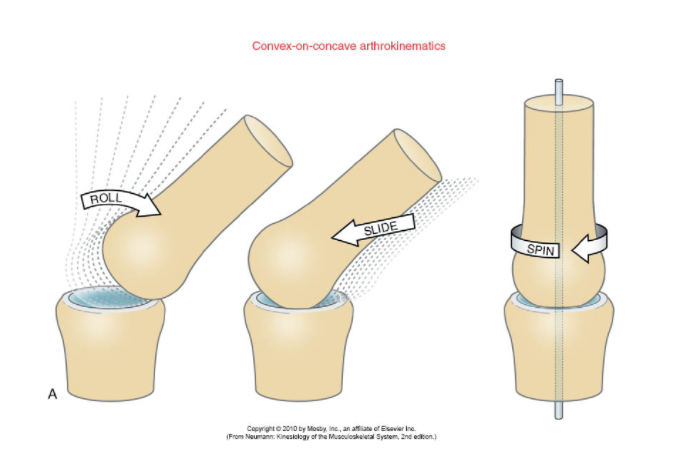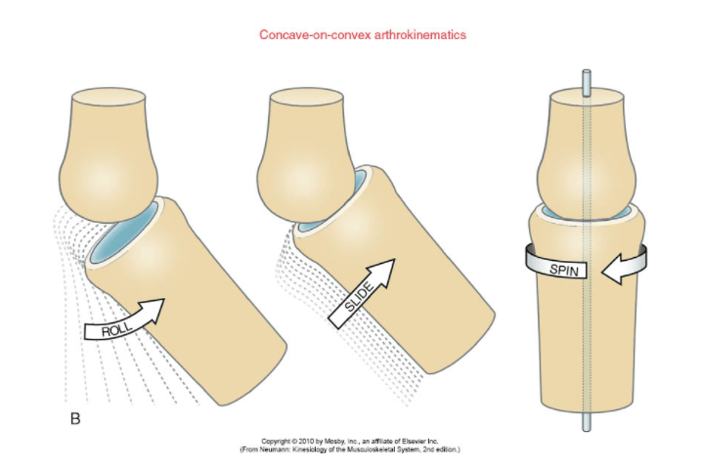The basics are always important, regardless of where you are in your career as a physical therapist. As a student, I am just now beginning to realize how important it is to never forget the basics. This became particularly apparent to me after learning about joint arthrokinematics.
As PTs, we are not able to open our patients’ joints when we want to see how they are moving through their available range of motion. Therefore, when it comes to the joints, it is critical that we understand all of this roll and glide nonsense. After all, rolls and glides are the basic motions that feed into more complicated movement patterns. Understanding the structure of joints and the principles of biomechanics is essential for grasping arthrokinematics, as they provide the foundation for analyzing joint mechanics and movement quality.
Introduction to Joint Surfaces and Arthrokinematics
Understanding joint surfaces is fundamental to grasping the concept of arthrokinematics—the study of how joints move. Joint surfaces are the specific areas where two bones come together and interact, allowing for the smooth motion that is essential in daily activities and athletic performance. There are two main types of joint surfaces: the convex joint surface, which is rounded and bulges outward, and the concave joint surface, which curves inward like a shallow bowl. These surfaces are most commonly found in synovial joints, which are the most mobile joints in the human body.
The way these surfaces fit and move against each other determines the quality and direction of joint motion. For example, the rounded end of one bone (convex) might roll and glide within the curved surface of another bone (concave), allowing for complex movements while maintaining joint integrity. Physical therapists rely on a deep understanding of these surfaces to assess, treat, and educate patients about joint mechanics. By studying how bones, cartilage, and other joint components interact, we can better understand the foundations of movement and the importance of maintaining healthy joint surfaces for overall mobility and function.
Visualizing joint arthrokinematics
I am a visual learner. When I first learned about joint arthrokinematics, I had to figure out a way to visualize joint movements even though I couldn’t physically observe motion through the skin or muscles.
I imagined a ball rolling along the inside of my cupped palm. The ball is round, but in terms of arthrokinematics, the ball is considered convex. My cupped palm creates a concave surface in which the convex ball can fit - just like a joint.
The “convex on concave” rule
Let’s visualize the “convex on concave” rule of joint arthrokinematics. First, grab a ball or a balled up piece of paper. Then roll the ball along your palm, starting at the base of your palm and moving up toward your fingertips. There will be a point at which the ball will roll out of your hand. This is exactly what happens in the joints too. However, instead of the ball rolling out of the joint and dislocating, there is a counter-motion to restrict excessive motion (hopefully). This counter-motion is known as a glide (AKA a slide). During these movements, compression occurs at the joint surfaces, helping to maintain joint congruence and stability.
Now glide the ball back towards the palm of your hand (in the opposite direction from which you rolled it). This is what occurs when any convex joint surface moves on a concave joint surface. According to the “convex on concave” rule, the roll and glide occur in OPPOSITE directions.
Muscles generate force that is transmitted across the joint surfaces, directly influencing the roll and glide mechanics during movement.
The “concave on convex” rule
Next, let’s visualize the “concave on convex” rule. Cup your palm and hold the ball still. Instead of moving the ball, move and roll your palm around the stationary ball. As your palm rolls around the ball, it also glides in the same direction.
There is no need for a counter/opposite glide here because the concave surface will continue to move around the convex surface. So, when a concave joint surface is moving on a convex joint surface, roll and glide occur in the SAME direction. Distraction, another small-amplitude arthrokinematic motion, can also occur at the joint, helping to maintain optimal alignment and joint congruence during movement.
Identification of joint surfaces
If you understand these basic arthrokinematics, then the hard part is done. The next step is knowing the different joint surfaces. This allows you to determine whether the motion is convex moving on concave, or concave moving on convex.
You may spend time memorizing the different descriptive terms for each joint, but to be honest, I never use specific names. I focus more on remembering each of the joint surfaces.
Take the knee (tibiofemoral joint), for example. The knee is referred to as a condyloid joint. However, that tells you nothing about the surfaces of the joint. In this case, the femur is the convex surface and the tibia is the concave surface.
Another example is the shoulder joint, where the humerus acts as the convex surface and articulates with the concave glenoid fossa. Understanding how the humerus interacts with the glenoid during shoulder movements is important for grasping joint kinematics and stabilization.
In all honesty, I had to look up the specific term, condyloid joint. However, without looking, I knew the surface types of the femur and tibia and I was able to understand how they move.
Concave Surface and Closed Chain Motion
The concave surface of a joint plays a crucial role in closed chain motion, where movement at one joint directly influences the movement of neighboring joints. In closed chain activities, such as squats or lunges, the concave surface of one bone moves in relation to the convex surface of another. Take the tibiofemoral joint as an example: during a squat, the concave surface of the tibia interacts with the convex surface of the femur, guiding the direction of movement during both flexion and extension.
This relationship is essential for maintaining joint stability and minimizing the risk of injury. The concave surface helps direct the movement of the convex surface, ensuring that the joint moves in a controlled and specific manner. For physical therapists, understanding the mechanics of concave and convex surfaces during closed chain motion is critical for evaluating joint function and developing effective rehabilitation strategies. Proper alignment and movement of these surfaces help preserve joint integrity and support safe, efficient motion throughout the body.
Open Chain Motion and Physical Therapists
Open chain motion describes movements where the distal segment of a limb is free to move, allowing for isolated joint action. This is particularly useful for physical therapists when they want to assess or improve the function of a specific joint. For example, during an open chain shoulder exercise, the humeral head (the ball-shaped end of the upper arm bone) rolls upward and glides downward within the glenoid fossa (the socket of the shoulder blade). This combination of roll and glide is essential for maintaining smooth, pain-free motion and joint stability.
Physical therapists use open chain motions to evaluate a joint’s range of motion, strength, and stability. By isolating a joint, therapists can identify specific limitations or dysfunctions and design targeted exercises to address them. Open chain exercises are especially valuable in rehabilitation after injury or surgery, as they allow for controlled, progressive movement that can be tailored to the individual’s needs. Understanding the principles of open chain motion helps therapists and patients alike to restore optimal joint function and reduce the risk of future injury.
Examples of joint arthrokinematics at the knee
Example 1: long arc quad
A long arc quad exercise is performed with open chain knee extension. When trying to understand the joint arthrokinematics for this exercise, I first ask myself to identify the surfaces of the joint. Which surface is convex and which surface is concave? Which surface is stable and which surface is moving?
At the tibiofemoral joint, the tibia is a concave surface and the femur is a convex surface. During a long arc quad, the tibia moves on a stable femur. Therefore, the tibia is rolling and gliding in the same direction on the femur.
Example 2: squat
A squat is performed with closed chain knee flexion. The femur is a convex surface and the tibia is a concave surface. During a squat, the femur moves on a stable tibia. The femur rolls posteriorly and slides anteriorly on the tibia. The roll and glide/slide occur in opposite directions, according to the “convex on concave” rule.
Application of Arthrokinematics in Joint Health
Applying the principles of arthrokinematics is key to maintaining healthy joints and preventing injury. By understanding how joint surfaces—such as the convex surface of the femur and the concave surface of the tibia—move and interact, individuals and physical therapists can identify and correct faulty movement patterns. For instance, during knee extension, the femur’s convex surface must roll and glide properly on the tibia’s concave surface to distribute forces evenly and avoid excessive stress on the joint.
Physical therapists use their knowledge of arthrokinematics to develop exercise programs that promote correct joint mechanics, helping patients move more efficiently and safely. Recognizing abnormal glides or restricted movement can alert both therapists and individuals to potential issues before they lead to injury. By applying these principles, it’s possible to enhance joint function, maintain a healthy range of motion, and support an active lifestyle. Ultimately, understanding arthrokinematics empowers people to take charge of their joint health and prevent problems before they arise.
Back to the basics
When evaluating and treating movement impairments, it is important to understand joint surfaces, which joint surface is moving, and which joint surface is stable. Then you can identify if the roll and glide are occurring in the same direction or in opposite directions.
We can use these simple explanations to explain joint motions when educating our patients and clients about range of motion and joint restrictions. While it is easy to use PT jargon with other physical therapists, we must be able to break down arthrokinematics to our patients in a simple and digestible manner.
While these arthrokinematic explanations may seem oversimplified to a seasoned PT, they are useful when first learning joint arthrokinematics and when educating our patients. It is key that both the patient and the physical therapist are able to understand and effectively communicate basic concepts and principles of movement. A strong understanding of these basics is leading to better patient outcomes and more effective communication.
References
Neumann, D. A., & Kelly, E. R. (2010). Kinesiology of the musculoskeletal system: foundations for physical rehabilitation. St. Louis: Mosby/Elsevier.


